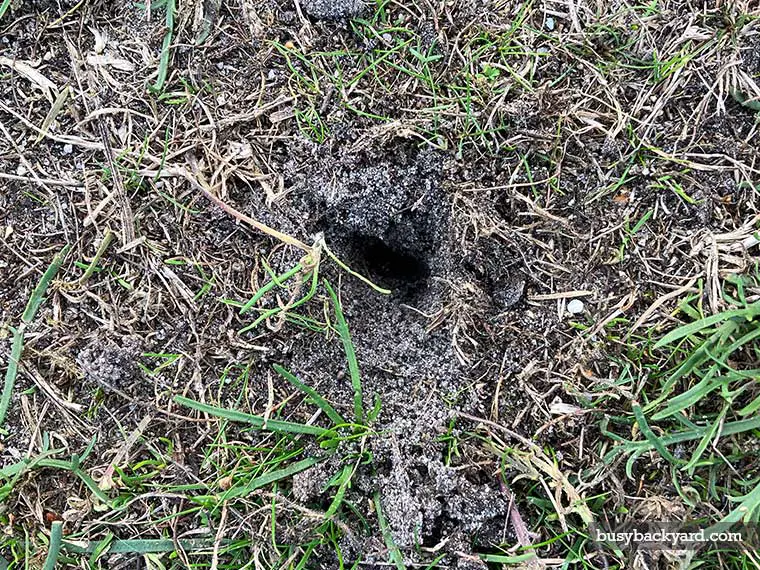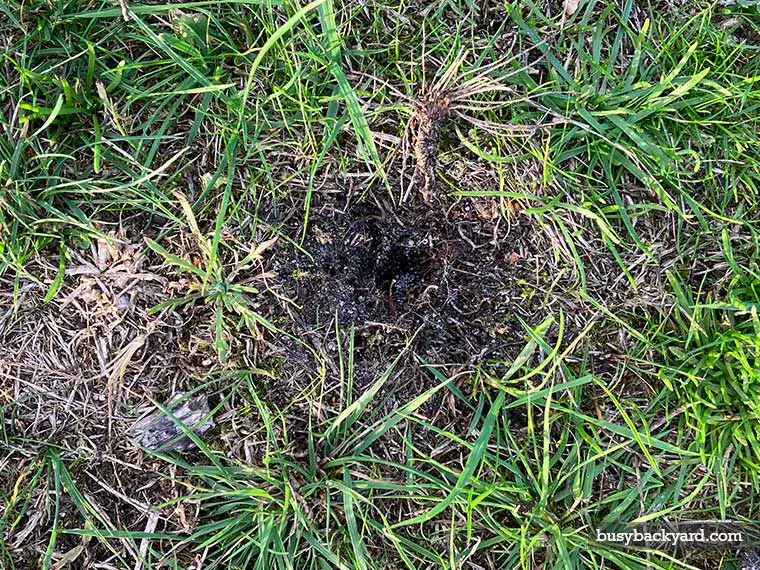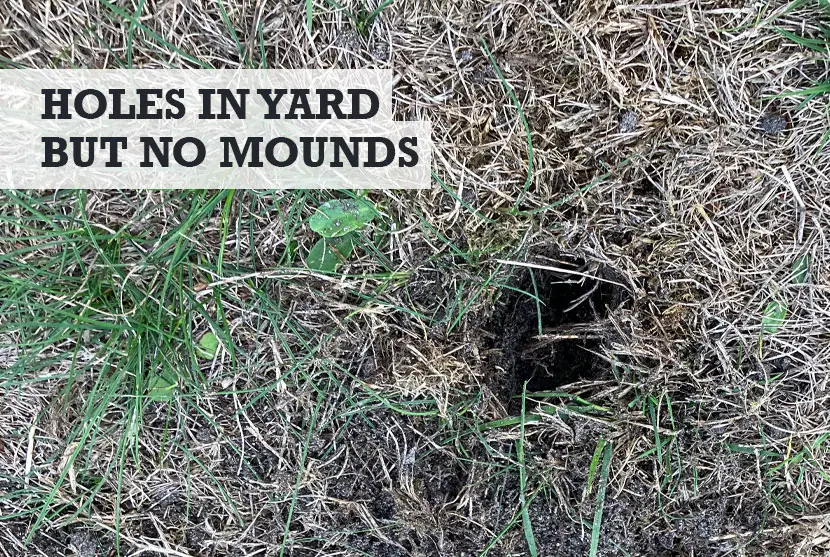One of the more mysterious and frustrating backyard conundrums will be those random holes that can appear with no mound next to them.
Sometimes these small holes in your yard can seemingly appear overnight… which begs the question: why are there small holes in my yard with no mounds?
Small holes can appear in your yard with no mounds for different reasons. Ascertaining the culprit means checking how big the holes are. Some of the possible causes include mole crickets, birds looking for food, mining bees, squirrels, or other critters and insects.
Now I appreciate that’s not the cut and dry answer you’re looking for, but that’s because we need to figure where you live and the type of insects and creatures nearby and how big the holes are.
What I’ve done to help you figure out what is making the small holes in your yard despite there being no mounds is to list the most likely reasons below. It includes how to recognize each one and possible ways to stop the small holes appearing in your backyard.
Possible reasons for small holes in a yard, but no mounds
1. Birds looking for food
The most obvious explanation is birds looking for food. Larger birds like blackbirds, crows, magpies, and starlings will peck at the grass lawn in your yard, leaving small, circular holes, with no obvious dirt mound left.
You can prevent birds from digging up your garden lawn or backyard grass patch with various methods. Some of the most popular include scarers and sprinklers. In the past I’ve used a motion detecting sprinkler to scare off critters digging at my lawn – you can set it to only go off when detecting certain sized animals including large birds.
The one I bought is still available on Amazon.
This will also work to discourage critters like squirrels, chipmunks, racoons, or armadillos which I will discuss lower down the page.
Handy Hint: A guide to chipmunk holes vs snake holes in your backyard.
2. Squirrels
Squirrels love to dig small holes in yards and lawns and will often flick the earth quite a distance away. This means that small holes in your yard made by squirrels won’t have mounds of soil next to them.
If your tiny holes are a couple of inches in diameter, you have trees and woods near you, then it could be squirrels digging your backyard to bury nuts.

You can discourage them off your lawn with that sprinkler on Amazon I mentioned earlier, making sure trash in your yard is sealed and secure, buy a pretend predator or use a repellent – more tips are in this guide.
3. Mole crickets
Mole crickets can be found under turf in the eastern and central states stretching from Nebraska to Texas, and from Ontario in Canada down to Florida in the US again. They are also very common in Australia.
This insect uses claws to dig through the lawn surface in your yard, creating a tunnel to shelter in. Because mole crickets are small, the holes in your backyard will be small as well, with very little earth left in a mound on the surface.
Despite it being just a small hole, be warned, it’s deceptive. Mole cricket tunnels can reach as deep as 30 inches underground and up to 20 feet long! It’s incredible really, and if you have a lot of the critters, it can do untold damage to your yard’s lawn.

As well as the small tunnels collapsing, they can also raise the roots of your lawn and soil, drying it out in the summer months.
There’s a very cunning way to check if it is mole crickets making the tiny holes in your yard. This hack also works for other hole-making critters and insects too.
It’s the soap test. Dilute dish soap and water, then pour the soapy water down one of the small holes in your yard. Mole crickets hate this and will immediately come up to the surface to avoid drowning.
To get rid of mole crickets making holes in your yard without mounds, think about what it is that’s attracting them in the first place.
They thrive on lawns that have a thick thatch on top which can be caused by undecomposed grass clippings on the lawn’s surface. This can often be exacerbated by excessive watering or too much fertilizer.
4. Mining bees
Another possible insect responsible for making those small holes in your yard with no mound is a mining bee. There are 1,300 species of mining bees around the world so it’s likely they are in your backyard or garden no matter where you live.
Unlike honeybees in a colony, they don’t have a queen, but instead live in a large group of males and females.
Mining bees dig holes to shelter from the elements but also to lay their eggs in. The small holes they dig in your yard will have a small tiny mound around the outside, like fine soil granules – you might not even notice the mound.
A humane way to get rid of the mining bees that are making small holes in your yard’s lawn is to use cinnamon in the soil or by spraying a vinegar-water solution. You simply mix half water with half white vinegar.
When you spray this mix onto the lawn where the tiny holes with no mounds are, it can often deter the mining bees. They don’t like the strong smell so spray it liberally around their burrow holes.
You can learn more about these fascinating insects on the Heath Hands website.
“Mining bees are ground-nesting solitary bees which excavate nest tunnels in the soil. The solitary part refers to their nesting habits rather than their social lives. You may see them in aggregations numbering the hundreds around nesting sites, but each female cares for her own nest burrow.”
5. Critters like armadillos, chipmunks, racoons, or skunks
Other animals could be responsible for the small holes in your yard. For example, chipmunks like to dig holes near tree stumps and log piles. Just like squirrels, there will be no mound by the small holes, and they will be a similar size: two inches in diameter.
And… just like squirrels before them, they won’t like motion detecting sprays or similar scare tactics to keep them off your lawn.
Skunks are also good at making small holes in the yard, as are racoons, or armadillos. Most of these critters are looking for grubs. Do a little digging in the yard yourself to about an inch deep, pull back sod, and look for grubs.
If there are grubs under the lawn, it’s what the critters are after and why they are digging those tiny holes with no mounds in your yard.
You need to get rid of the grubs. The best solution is to use nematodes like these on Amazon.
6. Voles
Another critter that leaves a very distinctive hole in your yard will be a vole. Me personally, I am not too bothered by the holes left by a vole if it’s not in the lawn. If it’s in my beds, I am happy to let the balance of nature do its thing.
However, if the small holes without the mounds are doing harm to the plants in my yard, I will act – and that’s where my cat comes in.
You might start to see dead voles, and if that’s coupled with the holes in your yard being 1 to 1.5 inches in diameter, you could have your culprit.
Voles tend to come in after moles make tunnels. Moles will leave mounds, voles will not.
Garter snakes can prey on them. So, if you have tiny holes, no mounds, and a vole problem, let the garter snakes do their thing – they might then take the hole over, and become a great predator of rodents.
Pushing rat poison down the tiny holes can be a temporary fix. Do that, then fill the tiny holes in. But voles will be an on-going problem. Which is why a cat could be good.
Handy Hint: Did you know that Copperhead snakes steal the holes of other animals live in? Here’s what to look out for.
7. Football or soccer studs / moulded spikes
I had to include this after being contacted on social media by someone who asked me why there were holes in their backyard… after a little dialogue and them showing me the photos, it turned out the culprit was his two sons.
He didn’t know, but before he came back from work, his boys were playing football in the yard in their full kit.
As you can imagine, the small holes in his yard had no mounds as it was the spikes or studs in their boots pushing the holes into the grass and soil!
Conclusion
Having spent so long making your yard lawn and grass just perfect, to suddenly notice the appearance of random holes in your backyard can be a real kick in the guts.
It’s particularly strange if there’s no mound by the hole as it makes you wonder just how the tiny holes in your yard appeared… until now!
As you can see, there are multiple reasons why you might find holes in a yard but no mounds.
It’s how you deal with it that can become the headache!



